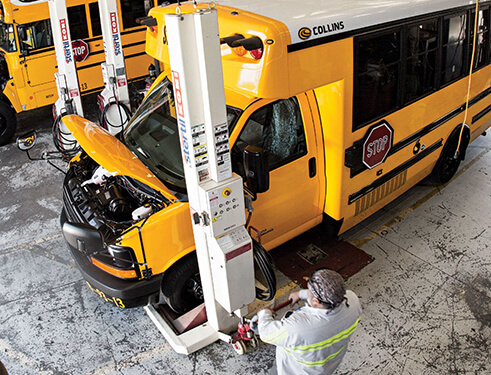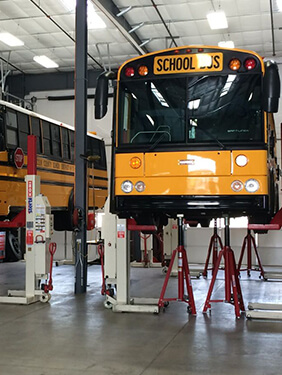Welcome to Guardian One


The Preventive Maintenance Program at Guardian One Transport is a term used to describe the performance of regularly scheduled maintenance activities on a vehicle in order to prevent the possibility of malfunctions, to extend vehicle life, and to reduce maintenance and operating cost. If the majority of our vehicle repairs are made after the vehicle experiences a mechanical failure, we do not have a functioning preventive maintenance program. A well-established comprehensive preventive maintenance program is as important to a successful school transportation system.
The main objective of preventive maintenance program at G1 is as under:
The maintenance arrangements at G1 will be arranged in the following variety of ways to fit our system needs:
Preventive maintenance Program (PMP) consists of scheduled servicing, inspections, and vehicle repairs to prevent potential problems and maximize vehicle availability. Preventive maintenance is used to proactively avoid or reduce vehicle breakdowns and is based on time, mileage, engine hours, or fuel used. Preventive maintenance actions include vehicle inspection, lubrication, adjustment, cleaning, testing, repair, and/or worn parts replacement.
To maximize the availability of vehicles, PMP services must be performed on a scheduled basis. If preventive maintenance is not performed regularly, vehicle life span will be greatly reduced. Some vehicles may be prone to excessive breakdowns requiring expensive repairs, causing a vehicle to be out of service when least expected, possibly when needed most and hamper smooth operations of the School. Vehicles may become unsafe due to lack of PMP. Proper maintenance will also help prevent litigation from negligence.
Preventive maintenance program is as important as driver safety programs. If a vehicle becomes unsafe due to lack of maintenance or repair, the company can be held liable for negligent entrustment. At G1, we understand the liability premised upon providing an employee with a dangerous tool or instrument, such as a vehicle, while knowing, or having reason to know, that use of the vehicle creates unreasonable risk or harm to others. Simply stated, the vehicle must be safe to operate. Should the brakes fail causing a serious crash or fatality, the vehicle is impounded by authorities for investigation.
Should the investigation determine that bad breaks or other vehicle malfunctions contributed to the accident, the authorities can seek a court order to obtain vehicle maintenance records. If your operation fails to practice preventive maintenance under these circumstances, you could be prosecuted for a negligent act, which you failed to prevent.
Vehicle maintenance and repairs can be performed in one of two methods:
A scheduled vehicle service consists of preventive maintenance, scheduled component repairs, and driver inspection. Unscheduled breakdown maintenance is most often due to lack of preventive maintenance. Reactive maintenance can be costly and should be minimized by a proactive preventive maintenance program. The object is to have the majority of vehicle maintenance and repairs scheduled rather than unscheduled.
An effective PM program should consist of the following:
An effective PM program should include a task list of both preventive maintenance and safety items. The following should be addressed during a routine preventive maintenance service: engine oil and filter changes; transmission fluid; fuel system; cooling system; engine and transmission mounts; drive shafts or CV joints; belts and hoses; tune-ups; electrical system components; braking system; steering and suspension system; tires, wheels, and rims; exhaust system; undercarriage and frame; exterior and interior lights; body, glass, and mirrors; windshield wiper system; horn; seatbelts and seat structures; fluid leaks; and auxiliary systems.
The vehicle operator is the first line of defense against unexpected breakdowns and repairs. It is important that the driver communicate vehicle problems immediately to fleet management. This allows the vehicle operator to participate in the PM program, proactively reducing breakdowns.
The following vehicle systems should be monitored by the driver:
The vehicle operator must be held accountable for inspecting these items. The PM program depends on the driver for continued success. Should the vehicle operator fail to inspect the vehicle prior to, during, and after a trip, a potential problem may go unnoticed causing a breakdown or unsafe condition.
Training and accountability are important. The vehicle operator must be trained on proper inspection procedures and be held responsible for failure to inspect and report vehicle problems. This requires the support of each department and senior management. As a team effort, the PM program can be a great success.